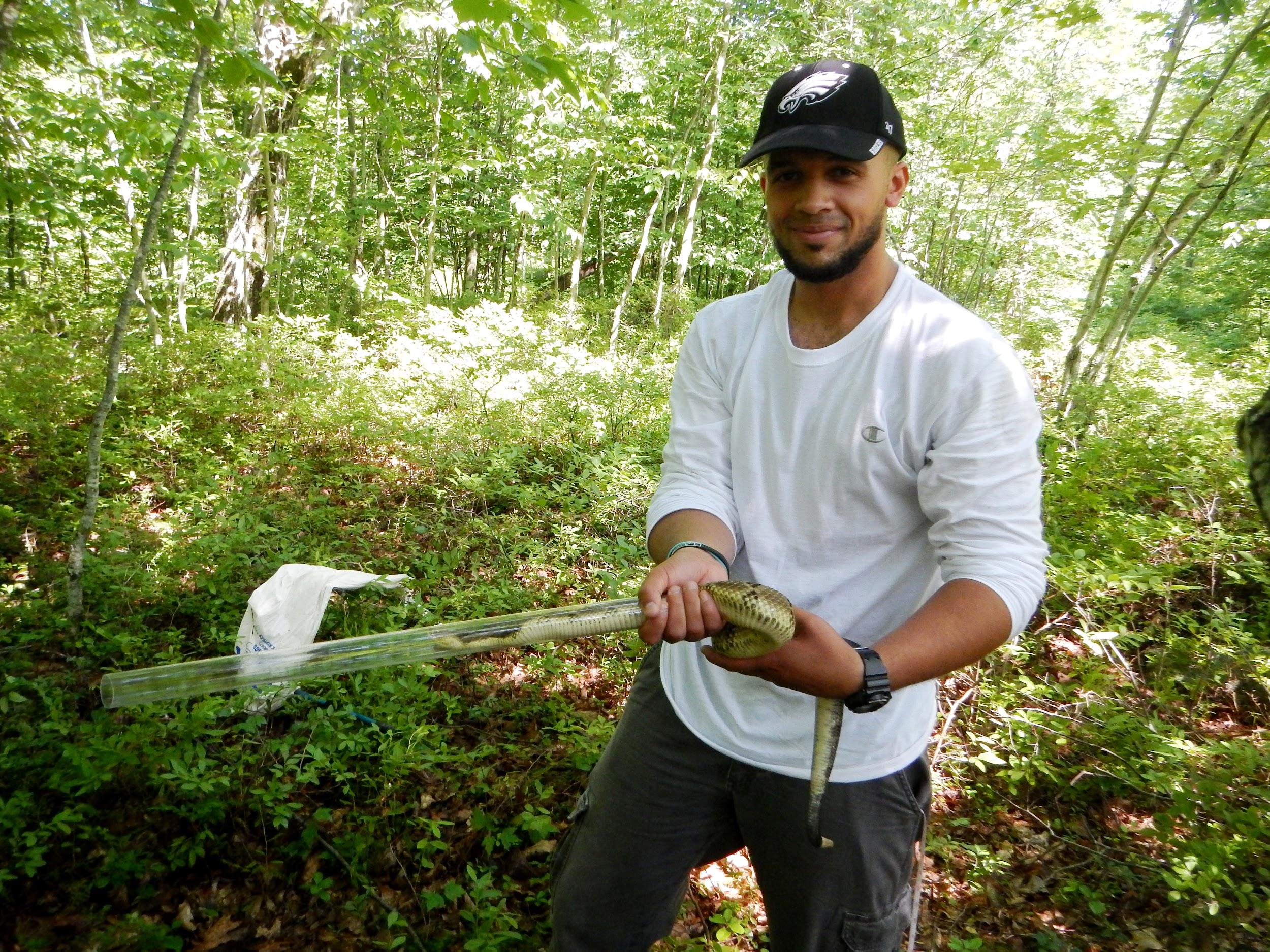
Researcher Studies One of the World’s Most Stigmatized Animals
Sebastian A. Harris is a graduate student and also a Timber Rattlesnake researcher. Recently, we were able to speak with him about this unique line of work.
Sebastian’s childhood strongly contributed to his interest in zoology. While growing up in the inner-city, he didn’t have many opportunities to get out into nature, but his parents were still able to foster his interest in wildlife. Sebastian’s father showed him Discovery Channel documentaries about nature and shared his large collection Zoobooks with his son. Sebastian’s mother took him to the Philadelphia Zoo so he could see all of the animals he was learning about firsthand. Additionally, Sebastian’s childhood heroes included Steve Irwin and Jeff Corwin, who are famous for their experiences with animals. All of these factors strongly contributed to his desire to become a zoologist.
Later on, Sebastian began his undergraduate program studying biology at Delaware Valley University. During this time, Sebastian worked as a naturalist at Wildlands Conservancy’s Pool Wildlife Sanctuary and through relationships formed here, secured the opportunity to gain field experience with some of Pennsylvania's rarest reptiles and amphibians. It was also during his time at Delaware Valley University, that Sebastian met his advisor, Dr. Gregory George, who connected Sebastian with a herpetologist at East Stroudsburg University. Through this relationship, Sebastian was offered the opportunity to study Timber Rattlesnakes for his Master’s thesis under the direction of Dr. Laduke.
Sebastian is currently still working on this Master’s program and when complete, he will have earned an M.S. in Biology. So far he has completed over 30-course credits and a comprehensive exam, he only needs to finish his dissertation before completing the program. The project for his dissertation studies whether or not pregnant rattlesnakes select habitats with specific features to gestate in. Sebastian hypothesizes that “rocks with particular dimensions, conducive to sustainable conduction, and surrounded by vegetation, which is optimal for crypsis, make up the ideal gestation habitat for Timber Rattlesnakes.” Sebastian still needs to analyze all of the data he has collected to determine the study’s findings. He did note that he has seen some very interesting rattlesnake behavior, for example, he found two females utilizing a dead tree that had fallen as a gestation chamber. This is unusual because rocks are usually what they choose to gestate within.
To gather data for this study, Sebastian must plan ahead, set due dates, and communicate frequently with committee members. To stay on track, Sebastian also tries to write every day, while information is still fresh in his mind. However, Sebastian also must remain flexible about when he can collect data because it depends heavily on the weather. He usually heads out into the field about twice a week. In the field, he uses traditional methods of habitat sampling including, “linear measurements of habitat features and quadrat sampling to determine percent cover estimates of habitat surrounding gestation rocks.” This particular project studies utilized versus available habitat, so stratified random sampling is involved. As Sebastian noted, “ensuring that samples are indeed random can be challenging but it's integral to comparative data.” Sebastian also uses a mapmaking program called ArcMap to gather information about other characteristics of the habitat such as slope and site elevation.
After learning all of this great information about the project, we still had to ask Sebastian, “Why rattlesnakes?” Sebastian says he has always been very interested in venomous snakes, and that they are often misunderstood. Timber Rattlesnakes are only aggressive when provoked and there is nothing inherently vicious about these animals, unlike what most people believe. One of Sebastian’s major missions is to reduce the stigma surrounding these types of animals. Overall, while he would not have turned down the chance to study any type of amphibian or reptile, Sebastian is very happy he was able to find a project studying rattlesnakes.
When not working on his dissertation Sebastian still remains very connected to nature. He is a passionate advocate for environmental awareness and education. He feels that humans need to better understand the environmental problems we face before we can join together in solving them. Sebastian also supports the efforts of the Pennsylvania Amphibian and Reptile Survey (PARS) which as he described, “has garnered a large number of volunteers who do outreach and contribute their findings to an online database. It has produced a number of citizen scientists and has done well with connecting Pennsylvanians to our native reptiles and amphibians.” Beyond this important conservation work, Sebastian also enjoys writing blog posts about nature for his website and volunteering with the North American Freshwater Turtle Research Group, helping with their study of Wood Turtles. Overall, Sebastian seeks out and participates in many unique experiences that enable him to engage his passions for zoology and nature.
At Conseris, we love helping passionate researchers reach their goals. Sign up for a free-trial today and learn how Conseris can help you better pursue your interests.
